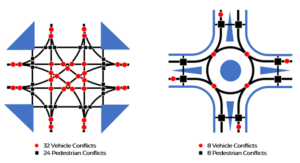Roundabouts. Traffic circles. Road circles… Whatever you want to call them, they’re on the rise across the United States and potentially in a community near you.
Some people welcome them with open arms, yet others are confused why they are better than an intersection with stop signs or traffic signals, not to mention how they even function. Some gripes you may have heard about roundabouts or even have thought yourself:
- “They are just unnecessary.”
- “They are confusing and don’t work as well as stop lights.”
- “Why do we need a roundabout in a rural area in the middle of a cornfield? There’s no traffic here!”
- “They are a waste of money.”
- “A good example of ‘planners gone wild’.”
I’m in the “welcome roundabouts with open arms” camp and hope to dispel any gripes others may have, as well as help everyone better understand how they work.
What are the benefits of roundabouts?
Simply put, roundabouts are safer for drivers, pedestrians, and bicyclists than both stop sign intersections and signalized intersections.
Safety is improved mainly due to three factors working together:
- The number of conflict points (i.e., where people can crash into each other) are reduced
- Vehicular speeds are lowered (drivers must slow down to navigate through)
- Pedestrians cross a shorter distance (see the image below)
As shown in the image, the number of vehicular conflict points are greatly reduced from 32 in a four-way intersection to eight in a roundabout, and pedestrian conflict points are reduced from 24 to eight.

*[1] Source: https://www.spanishfork.org/news_detail_T17_R163.php, Accessed July 26, 2021.
Not only are the number of conflict points clearly reduced in theory, data has shown that collisions are reduced by an average of 80% when roundabouts are used instead of a four-way intersection!
As for the gripe about a roundabout in the middle of a cornfield? Safety first! That intersection may be fraught with accidents. I remember there was a rural intersection that had horrible car crashes all the time near where I lived growing up in Iowa. People would be speeding up to the intersection and fail to notice a cross street, despite any yellow warning signs, and they’d drive through the stop sign, while a driver from the other direction did the exact same thing. In this rural location, a flashing red stop light would help people see the intersection better, yes, but it may be expensive to install, especially depending on availability of electricity nearby. Roundabouts can also be expensive to install, but they are less expensive to maintain than a traffic light over time. Now on the rural roads around where I grew up, there are now a handful of roundabouts. Check out this press release if you don’t believe me!
Second, a roundabout keeps you moving on your way, often without having to stop… read on.
Roundabouts can improve traffic flow and, thus, the efficiency of people’s travel time.
Why would a transportation department choose to install a roundabout instead of a four-way stop sign or traffic signal? Or even replace an existing four-way intersection with a roundabout? And especially in a rural area where there aren’t many cars?
To these questions, I’d question you:
- Have you ever waited at a red light with no other cars in sight, wishing you could just go already?
- Ever waited at a red light through multiple signal cycles wanting to turn left but unable to because of oncoming traffic, wishing you could just turn already?”
If it was a roundabout instead, you’d be on your way! Traffic flow is steady in a roundabout compared to an intersection that requires cars to stop. While you may have to slow down and yield or even stop before entering a roundabout, you won’t be competing against oncoming traffic or subjected to a longer red light.
How do I navigate a roundabout?
As with anything unfamiliar, roundabouts may require some new skills and take some time to get used to. Yet in the end, it will be worth it. Always remember that vehicular traffic in a roundabout all goes in one direction, and vehicles already inside the circle have priority. In other words, a vehicle in the circle will not stop to allow your vehicle to enter the circle from a side street.
For Drivers and Bicyclists
Below are some tips to safely navigate a roundabout.
- Take your time. Roundabouts are meant to slow vehicles down to 15-20 mph.
- Keep moving! Once in the roundabout, you have the right-of-way to other vehicles.
- But you still need to stop for pedestrians that may be crossing at the road where you want to exit the roundabout.
- Yield to pedestrians and vehicles already in the roundabout. Look left for vehicles, but don’t forget to look right for pedestrians like you would at a normal intersection, both before you enter and exit the roundabout.
- Stay in your lane. Don’t change lanes within the roundabout. The pavement parks will help guide you.
- Just like other types of intersections, you must be in the proper lane before entering – you’d never turn left from the right lane at a signalized intersection!
- Exit the roundabout for emergency vehicles. And then pull to the right once you’ve cleared the roundabout. Do not stop within the roundabout.
The U.S. Department of Transportation created this short video that shows and explains the “Rules of the Roundabout” that helps people visualize navigating a roundabout. The rules are simplified to 1) slow down; 2) look around; and 3) be ready to yield.
For Pedestrians
It’s not actually any different – use the crosswalk, and cross as you normally would at an intersection! The good news is that you will have a shorter distance to cross than if it were a four-way stop intersection, and there likely will also be a place for you to stand between lanes to ensure cars see you crossing.
Examples of Roundabouts in metro Atlanta:




